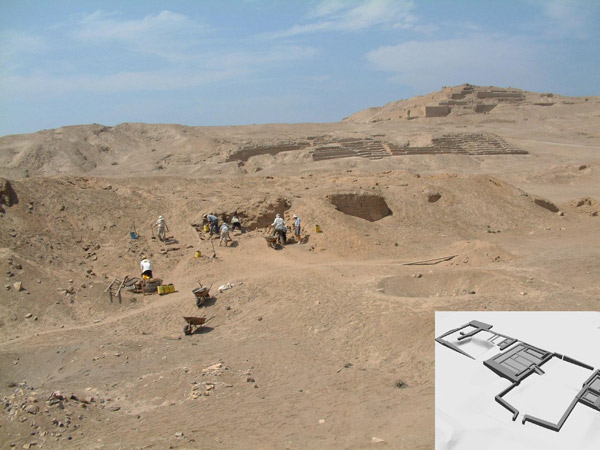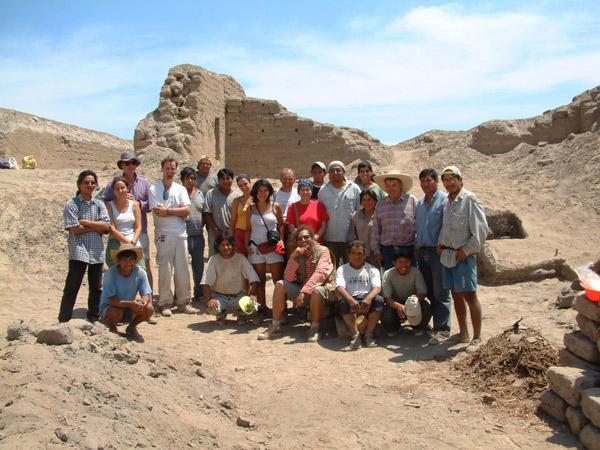


The 2003 field season at Pachacamac
![]() Three main lines
of investigation were followed this year: the chronology of the pyramids
with ramps; the definition of the inner transit system within the Second
Precinct or the pyramidal sector; and the topographic and planimetric
survey.
Three main lines
of investigation were followed this year: the chronology of the pyramids
with ramps; the definition of the inner transit system within the Second
Precinct or the pyramidal sector; and the topographic and planimetric
survey.
The chronology of the pyramids with ramps is being defined via precisely placed excavations within strategic loci in pyramids n°12, 13, and 15. It is worth recalling that the explanatory model which serves as a working hypothesis refers to dynastic succesion: each pyramid is the palace of a chief who built it, occupied it during his reign and was buried inside it when he died. His successor then built his own pyramid palace. Hence our goal is to determine as precisely as possible, for each of the pyramids, the moment of their foundation, the length of occupation and the date of voluntary abandonment.
Investigations in Pyramid n°12 have confirmed the hypothesis. It should be stated at the outset that Pyramid n°12 is a double pyramid, i.e. it is composed of two architectural units included within the same precinct. The stratigraphy there has enabled us to demonstrate the succession of the buildings within the complex: Pyramid 12A was occupied during two successive phases and was then abandoned and closed, while part of its front plaza was used to construct Pyramid 12B, which also has two successive phases before being abandoned in its turn. The whole complex was reused as camp site for pilgrims during the Inca Empire, while the storage facilities at the side were reused as funerary chambers during the same period. The construction phases for each pyramid are very interesting because they are marked by the growth of the central ramp, for the first phase is completely covered by the second one.
Unfortunately, the stratigraphy in Pyramid n°13 is not so clear : we have some evidence for the foundation but fewer clues as to when it was abandoned. This is because the Inca and Colonial occupations have had a profound effect on the structures. The post-conquest looting has also been very destructive. Future test pits in other parts of the building should provide further information about the duration of the initial occupation of Pyramid n°13.
Pyramid n°15 was discovered during the survey of 2002. It was identified on the basis of some structural features that are usually associated with this type of building, but the ramp was not visible, so we thought it had been destroyed. Excavations have confirmed this supposition but an earlier phase, relatively well preserved, was discovered. The destruction in the post-conquest era hinders our interpretation at this stage in our processing of the data. However, the detailed study of the material excavated, and absolute dates still being processed should enable us to work out the sequence of events there. The offerings that have been discovered, such as jewellery and gilded silver artefacts, attest to an occupation by the elite members of local society.
The internal communication system of Pachacamac has never been studied. Two main thoroughfares cross at the centre of the site : the East-West Street and the North-South Street aka Hernando Pizarro Street. This year's investigations focused on the ramifications of the South Street. This important avenue is the only one which connects the monumental sector to the exterior of the site. This was probably the path taken by local pilgrims in pre-Inca times, and then by foreigners from the different regions of the Empire under Tahuantinsuyu. Hence it is important to know how the flow of traffic was organized during those periods. Careful excavations have enabled us to show a series of different pathways through time. The architecture of these pathways and their evolution will not be described here, but will be illustrated later via the digital 3D modeling.
At present it is more interesting to describe the unique, totally intact, stratigraphic column revealed in one of our test pits. This relatively modest pit (8m2) showed 24 successive layers to a depth of 5m. These cover the entire permanent occupation at Pachacamac, from the beginnings of our era or the Early Intermediate Period (Lima culture, phases 3-4) ; through the Middle Horizon (with, among other things, the first discovery in stratigraphic context of sherds decorated in Pachacamac 2B style, one of the most famous ceramic styles of ancient Peru) ; the Late Intermediate Period (main object of our investigations and the Ychsma style) ; the Inca period (with very abundant material) ; down to our own period, for a contemporary offering was discovered in one of the topmost layers. The exceptional nature of this excavation has to be emphasized for, in spite of the fact that the site of Pachacamac is known for the four cultures that succeeded one another there, (Lima, Huari, Ychsma and Inca), their stratigraphic superposition had never been found in a one single locus before, as is the case here. Moreover, we have samples from each layer for radiocarbon dating, as well as architectural evidence in the form of stone, adobes, tapia, adobitos, all associated with the stratigraphy and representative of each of the above-mentioned cultures. In the penultimate layer, no. 23, a votive burial was found in a layer which probably corresponds to the very first occupation of the site. There is no doubt that this excavation will allow us to advance our understanding of the total chronology of the site.
![]()